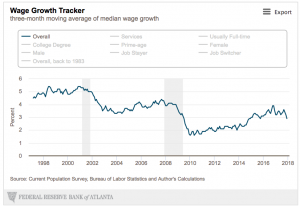SPECIAL REPORT: State of the Union 2018
Our team's special coverage of the 2018 State of the Union address
State of the Union style and substance: analyzing four presidents’ speeches
We’ve broken down the first State of the Union addresses of President Donald Trump and his three predecessors to show each leader’s individual style and substance.
read more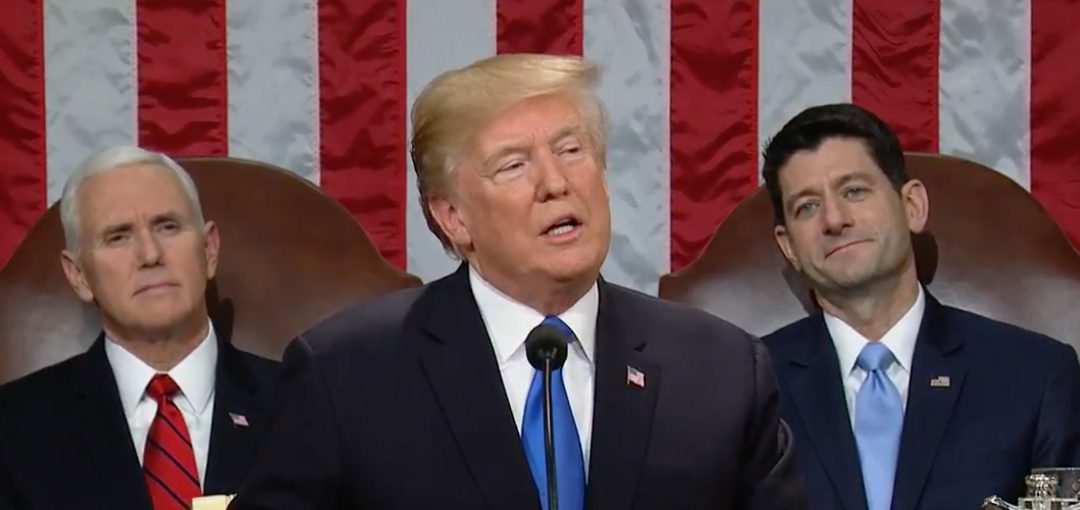
Calling for “a nation of builders,” Trump proposes $1.5 trillion infrastructure plan
Discussing his infrastructure plan in his first State of the Union address, President Trump said “we built the Empire State Building in just 1 year.” The president called for bipartisan efforts from Congress to fund $1.5 trillion in infrastructure investments.
read more
No mention of sexual harassment from Trump during State of the Union despite lawmaker support for #TIMESUP and #MeToo
Lawmakers expressed their support for the #TIMESUP and #MeToo movements at President Donald Trump’s first State of the Union address, but the president himself made no mention of the problem of sexual harassment that has dominated the news cycle recently.
read more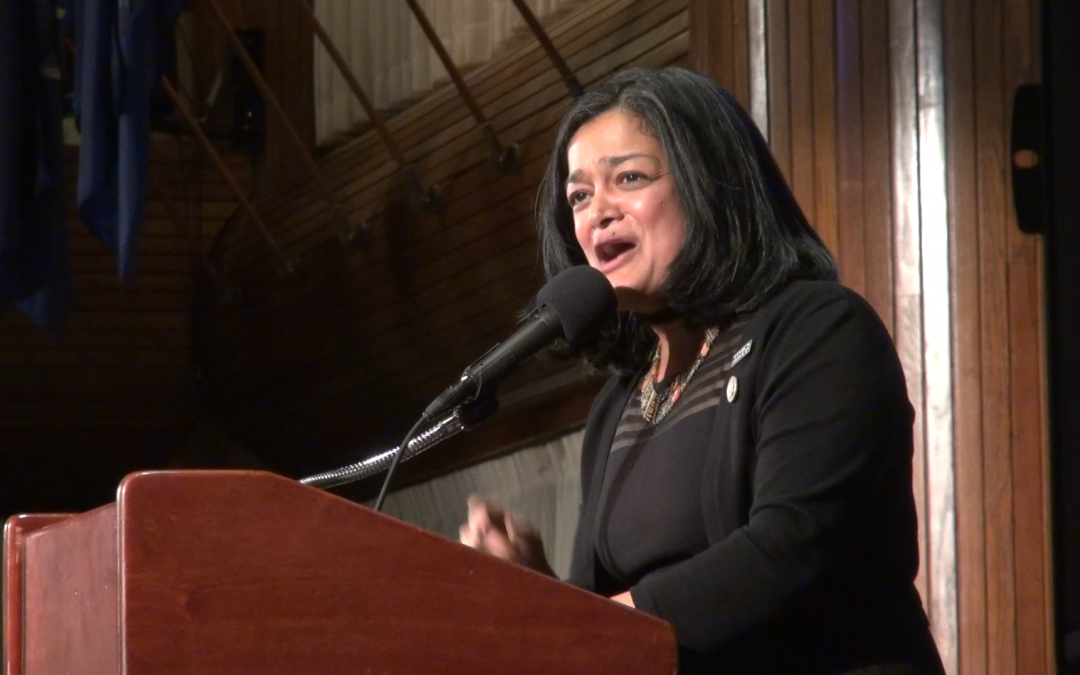
Members of Congress Stage Unprecedented Boycott of the State of the Union
Members of Congress Stage Unprecedented Boycott of the State of the Union More than a dozen lawmakers staged an unprecedented boycott of President Trump’s State of the Union Tuesday night. Included in that list were Civil Rights leader Rep. John Lewis of Georgia,...
read more
Trump told Congress his new immigration package is bipartisan. That’s when the Democrats laughed.
President Trump’s controversial immigration package cut Congress down partisan lines in his first Sate of the Union address. Cheers and boos clashed across the aisle as Trump declared his new legislation “bipartisan.”
read moreTax reform takes center stage at President Trump’s first State of the Union address
WASHINGTON — President Donald Trump kicked off his first official State of the Union address Tuesday by touting the success of his tax bill and taking credit for record stock market highs.
“Just as I promised the American people from this podium 11 months ago, we enacted the biggest tax cuts and reform in American history,” he said.
“Small business confidence is at an all-time high, and the stock market has smashed one record after another, gaining $8 trillion in value.”
Amidst a tense atmosphere in the House chamber, where Trump addressed a joint session of Congress and guests, he received a standing ovation from Republicans when he heaped praise on America’s economic success under his tenure, while Democrats remained seated with stoic expressions.
“Our massive tax cuts provide tremendous relief for the middle class and small businesses, and since we passed them roughly 3 million workers have already gotten tax cut bonuses – many of them thousands of dollars per worker,” he said.
Economic boom has been perhaps the most positive news to come out of Trump’s first year in office. Since signing the $1.5 trillion tax overhaul bill in December ‒ which delivered permanent tax cuts for corporations by dropping the corporate rate from 35 percent to 21 percent ‒ national economic growth has continued to increase at a steady pace, with the government reporting a GDP annual growth rate of 2.6 percent in the final quarter of 2017.
While the president has been citing ‒ and even exaggerating ‒ the amount workers across the country are receiving in bonuses as a direct result of his corporate tax cuts, economists warn that overall the bill is still skewed to primarily benefit the very wealthy.
A recent Reuters/Ipsos poll found that merely 2 percent of workers have reported receiving a bonus or raise as a direct result of the tax cuts, as further evidence of the fleeting, short-term effects the bill has on low and middle-income workers.
“I think the kind of rush of companies coming out and saying they’re handing out bonuses was more of a PR strategy than one that shows real, lasting impacts on the future paychecks of American employees,” Alex Rowell, a policy analyst at the progressive Center for American Progress, said. “As far as lasting wage increases for workers, you’re really not seeing that by giving them these one-time bonuses.”
Trump’s remarks paralleled those from his speech at the World Economic Forum in Davos, Switzerland last Friday, where he stated that the world is witnessing the resurgence of “a strong and prosperous America”. He specifically referred to his “massive” tax overhaul and elimination of regulatory reductions as proof of policies that have stimulated the U.S. economy.
“America is open for business, and we are competitive once again,” he said.
However, experts are hesitant to attribute a robust economy directly to Trump’s policies, citing a variety of other contributing factors carried over from his predecessor such as an already strong labor market, ongoing job growth and a decreasing unemployment rate.
“You can’t take credit for the continuation of an ongoing trend,” said Heidi Shierholz, director of policy at the Economic Policy Institute, a think tank focused on improving the lives of people with low and middle incomes. “If things looked markedly different from their longer run trends, you’d start to wonder what Trump had done to cause that…but that’s not the case.”
Shierholz also said that the tax bill contributes to the trend of wage stagnation for middle class workers and rising wage inequality. Since corporate profits are already high, their incentives to invest in firms and establishments that will generate economic activity at all levels won’t be affected by additional tax cuts, she said.
“During the campaign, he made blue-collar workers feel like he understood their economic insecurities and would do something about them, but since he took office every time he’s had to choose between prioritizing corporate interests or the interests of workers, he’s chosen corporate,” she said.
Illinois representatives divided over State of the Union attendance
Live Fact Check: State of the Union 2018
Keep up with #SOTU18 as reporters Anna Laffrey and Maggie Harden fact-check President Trump’s first State of the Union address in real time.
22.47 How did Trump do overall with accuracy? Politifact says several of his points were “fatally flawed” and the speech overall had “mixed accuracy,” and we agree. He correctly stated statistics regarding ISIS and drug overdose, but his points on tax and immigration reform were particularly misleading. To continue following our SOTU coverage, stay tuned for stories like these: Anna Laffrey will be reporting on infrastructure, Catherine Kim and Kristina Karisch are compiling an infographic comparing this address to others, and other reporters will be gathering reactions from both sides of the aisle. -MH & AL 22.32 Trump finishes his first official State of the Union with some uplifting prose. “Americans fill the world with art and music. They push the bounds of science and discovery, and they forever remind us of what we should never never forget… There is nothing we cannot achieve as long as we have confidence in our values, faith in our citizens, and trust in our God.” Trump said “It’s the people who are making America great again.” -AL 22.22 North Korea talk will start Trump’s “big finish,” says The Huffington Post on Twitter. Trump's big finish tonight starts with North Korea. #SOTU — HuffPost (@HuffPost) January 31, 2018 -AL 22.21 “No regime has oppressed its own citizens more totally or more brutally than the cruel dictatorship of North Korea.” Trump says we are waging a campaign to prevent any nuclear aggression from North Korea. He says he will not repeat the mistakes of complacency and concession that have led to danger in the past. Trump was expected to go hard on North Korea, root for more defense spending. https://www.cnbc.com/2018/01/30/trumps-state-of-the-union-to-give-forceful-warning-on-north-korea.html -AL 22.18 @POTUS addresses ongoing threat of ISIS and terrorism, saying “Terrorists are not merely criminals. They are unlawful enemy combatants.” To applause from Republicans, he says he signed an order to keep open detention facilities at Guantánamo Bay. via @ohmy_godbole — Medill on the Hill (@medillonthehill) January 31, 2018 22.10 President Trump said that the coalition to defeat ISIS has liberated almost 100 percent of territory. FACT CHECK: This is true, although this trend did not start with Trump’s presidency and Syria is still currently undergoing a massive civil war. -MH 22.08 President Trump said he wants to end the process of immigrants being able to bring in a “virtually unlimited number of distant relatives.” FACT CHECK: Immigrants who are current U.S. citizens can only sponsor immediate family members, including parents, children, or spouses/fiancées. How many people they can sponsor depends on the U.S. citizen’s income and relationship to the incoming immigrant. -MH 22.03 President Trump brought up how over 64,000 people died in 2016 from drug overdose. FACT CHECK: This is true, and means that more Americans died of drug overdose in 2016 than died in the Vietnam War. More than 75 percent of these overdoses were opioid overdoses, which is an issue President Trump has declared a public health emergency but has done relatively little to combat. -MH 22.02 Trump outlines four pillars of immigration policy. Here’s a breakdown, using some of Trump’s words: He calls these four pillars a “down-the-middle compromise” that will create a “safe, modern and lawful immigration system.” -AL 21.56 .@POTUS calls for Washington to support working families by supporting paid family leave. via @pdvarona and @libbyaberry — Medill on the Hill (@medillonthehill) January 31, 2018 21.55 “Tonight I am extending an open hand to work with members of both parties, Democrats and Republicans.” Trump was expected to call on bipartisanship at the address. He said all Americans are “dreamers.” -AL 21.52 Trump is hammering away on immigration policy. “Open borders have allowed drugs and gangs to pour into our communities.” He’s talking about the families of two young girls killed by MS-13 gang members. This has been one of Trump’s strategies since the early days of his campaign. Last week, the White House released a framework for Immigration Reform and Border Security. He laid out some minimum tools necessary: a billion trust fund for the border wall system; additional funds to hire new DHS and ICE personnel; ensuring the detention and removal of criminal aliens, gang members, violent offenders, and aggravated felons; among others action items. -AL 21.50 POTUS: Open borders have “allowed millions of low-wage workers to compete for jobs and wages against the poorest Americans.” FACT CHECK: According to the Pew Research Center, the U.S. workforce includes about 8 million undocumented immigrants. However, the U.S. does not have open borders. -MH 21.47 "The era of economic surender is over." via @RenzoDowney — Medill on the Hill (@medillonthehill) January 31, 2018 21.46 Trump says $ 1.5 trillion will be invested for a new infrastructure plan. This is different than what he told a group of the nation’s mayors last week – he first said $ 1 trillion, but said it would likely actually be a $ 1.7 trillion project. “Any bill must also streamline the permitting and approval process, getting it down to no more than two years… Together we can reclaim our great building heritage.” -AL 21.44 Trump: “It’s time to rebuild out crumbling infrastructure.” He says we build the Empire State building in a year, but it can take up to 10 years to get a permit for road construction to be approved. He’ll calls on bipartisanship for a “safe, fast, reliable, and modern” infrastructure plan. A budget proposal leaked to Axios last week sheds some light on what this plan might actually look like. Federal incentive grants should use up 50 percent of the allotted budget. 25 percent will be dedicated to rural issues, specialized for every community. There will also be funding meant specifically for “innovative or transformative” projects getting off the ground. -AL 21.43 Trump said earlier in his speech that “millions of Americans will have more take-home pay starting next month.” Note that the Americans receiving the most increases in income, according to the Urban-Brookings Tax Policy Center, are the ones already in or above the ninetieth income percentile. -MH 21.42 Some Dem members snickered after @POTUS said the past year has brought a government that represents more Americans. via @JakobLazzaro — Medill on the Hill (@medillonthehill) January 31, 2018 Medill News Service reporters follow along from the chamber @medillonthehill 21.40 POTUS: Last year, the Federal Drug Administration approved more drugs than ever before in U.S. history. This claim is true, with 46 new medicines receiving an approval from the FDA in 2017. -MH 21.40 Trump said Alabama was chosen as the site of a new auto plant by Toyota and Mazda. That’s true — the two Japanese companies said the plant would open in 2021 and be capable of making 300,000 cars a year. It’ll cost $ 1.6 billion to build. -AL 21.39 Trump announced that Chrysler will be moving a plant from Mexico to Michigan. However, CNN reports that Fiat Chrysler is not shutting down its plant in Saltillo, Mexico, but rather simply moving some operations to Warren, Michigan. In total, Fiat Chrysler has six plants in Mexico. -MH 21.37 Trump: “We have ended the war on beautiful, clean coal.” -AL 21.36 Trump nominated 24 level three judges this year — including Supreme Court justice Neil Gorsuch. This was one of Trump’s real lasting achievements from his first year. He nominated 13 judges for the United States Courts of Appeals, 10 judges for the United States District Courts. But, one of his nominees was withdrawn because he couldn’t answer basic legal questions. That was Matthew Spencer Petersen, who was up for a seat on the D.C. District Court. There are currently 51 nominations to Article III courts awaiting Senate action, including 7 for the Courts of Appeals and 44 for the District Courts. -AL 21.36 “In our drive to make Washington accountable, we have eliminated more regulations in our first year than any administration in history,” the president said during his address. FACT CHECK: The Washington Post reports that, compared to his most recent predecessors on their first sweeps through regulations, he has cut the most out of Clinton, Bush or Obama. However, experts say the number of regulations withdrawn might not be the best metric, because those are rules that never went into effect to begin with. There are few other metrics that would really prove this, and so in reality it’s hard to tell, according to experts. -MH 21.32 President Trump said earlier in his speech that wages are finally on the rise, after years of wage stagnation. Here’s a chart from the Federal Reserve Bank of Atlanta detailing the last twenty years of wage changes — note that they have been generally increasing since 2010 and started stagnating only beginning in 2017. -MH 21.23 President Trump has said his recent tax overhaul is the biggest tax reform in American history. FACT CHECK: The tax overhaul recently passed under President Trump is not the largest in American history. Tax reforms passed under Presidents Reagan, Obama, and Bush all amount to bigger cuts as a share of the economy and in inflation-adjusted dollars, according to the New York Times. -MH 21.22 President Trump said that his administration has created 2.5 million jobs since the election, and that the country is finally seeing wage rises after years of wage stagnation. FACT CHECK: Approximately 2.5 million jobs have been created since Trump’s election (which notably includes the last three months of Obama’s presidency). However, as with any president, it takes at least several months for the economy to undergo change based on any policy. -MH 21.21 Trump: “Since the election, we have created 2.4 million new jobs, including — including 200,000 new jobs in manufacturing alone. Tremendous.” Does this apply to African Americans? Yes, black unemployment rate is currently 6.8%, the lowest in 45 years. However, this trend started under Obama, and has not intensified under Trump. Black unemployment rate has been steadily falling since 2010. -AL & MH 21.13 President Donald Trump: “We have gone forward with a clear vision and a righteous mission. To make America great again, for all Americans.” “We have endured floods and fires and storms. We have seen the beauty in America’s soul, and the steel in America’s spine.” -AL 21.13 President Trump opened by speaking about the optimism the country has had since his last address to Congress, despite the fact that his approval rating (38 percent) has reached historic lows -MH 21.04 SCOTUS is entering – only 4/9 justices are present. via @JakobLazzaro — Medill on the Hill (@medillonthehill) January 31, 2018 Reporter Jakob Lazzaro tweeted that four of nine Supreme Court justices are present. Ginsburg, Kennedy and Sotomayor have prior engagements. Alito hasn’t been since Obama’s 2010 SOTU, where he was caught shaking his head. Thomas has called the speech a partisan event, and has no interest in attending. -AL 20.58 Reporter Caroline Vakil is at The George Washington University watching the speech with a college republicans group. Here’s her preview about students and #SOTU. College Republicans optimistic before Trump’s State of the Union address -AL 20.53 The First Lady has also invited some public servants who responded to national crises this year. Jon Bridgers founded a hurricane rescue and recovery non-profit in south Louisiana. Coast Guard technician Ashlee Leppert rescued dozens of Americans during hurricane season. And in July 2017, David Dahlberg saved 62 children and staffers from a summer camp while fire prevention technician in California. (from Anna Laffrey) 20.53 We’re all watching the crowd this year, Maggie. We know the First Lady will bring special guests to the State of the Union, just like every year — usually symbolizing an ideal that is included in the president’s speech. Police Officer Ryan Holets is among special guests seated with the First Lady this year. Holets adopted a baby from parents who were addicted to opioids, bridging between law enforcement and abusers. Trump launched a commission to study the opioid epidemic, but has not allotted any additional funding since. Does this guest indicate some sort of action might be taken to address a drug influencing so many Americans? (from Anna Laffrey) 20.51 In addition to ISIS, the president is expected to give a “forceful” warning to North Korea, according to reports from CNBC (perhaps he will echo earlier sentiments he made about the U.S. “nuclear button”). Anna, can you tell us a little bit about which guests will be in attendance tonight? (from Maggie Harden) 20.51 20.44 Trump is expected to tout efforts against ISIS, liberating regions of Iraq and Syria. Maggie, any other themes we should be expecting from the speech this year? (from Anna Laffrey) 20.37 President Trump is expected to primarily focus on the benefits of his recent tax overhaul, immigration and infrastructure, according to expert predictions. Experts also raise questions of whether the president will be able to stick to his prepared remarks, which was something he was praised for at a joint address last year. (from Maggie Harden) 20.28 According to excerpts released by the White House, Trump will say “There has never been a better time to start living the American dream” and that “Together, we are building a SAFE, STRONG, and PROUD America.” From the looks of the excerpts, Trump will tout economic growth and grapple for bipartisanship. from Anna Laffrey 16.00 White House officials previewed President Donald Trump’s first official State of the Union as being “bright and optimistic,” bouncing from the “American carnage” of his inaugural address last year. Trump said he’s striving for national unity at the traditional lunch with news correspondents Tuesday afternoon. Trump’s been making impromptu edits to the speech today, and for the past few weeks, the White House said. (from Anna Laffrey)
~@POTUS 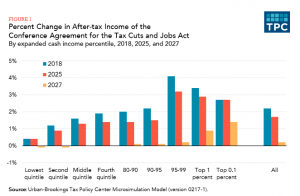
State of the Union: What to Expect
College Republicans admire unification theme in State of the Union address, praise Trump’s first year in office
WASHINGTON — College Republicans praised President Donald Trump’s first year in office Tuesday and found relatable themes during Trump’s State of the Union address.
Allison Coukos, a senior and chair of the George Washington University College Republicans, said the theme of national unification resonated with her the most while watching the president’s address at a State of the Union watch party.
“When you see the Democrats – I’ve always understood there is a role for the opposition party, the minority party, but when you flat out refuse to work with the president, you’re not helping Americans, you’re trying to further your own political points,” Coukos said. “So when you have Trump coming in saying we need to focus on unification, we need to focus on the Americans first and foremost, politics aside, that’s I think the call of a leader.”
Hunter Ihrman, a freshman and another member of the GW College Republicans, appreciated Trump’s focus on Americans in his speech.
“He’s also done a really good job of mentioning the accomplishments of a lot of ordinary Americans. I’m actually really inspired by the way he’s forging forward together,” Ihrman said.
Many College Republicans agreed that one of Trump’s challenges was his rhetoric and handling of social media. Some were concerned that Trump’s tweets and controversial remarks would distract their fellow college Republicans from his actual accomplishments.
“There’s sort of a disconnect between Trump the character and Trump the president. Hopefully, eventually, we’ll see a merger of the two,” Coukos said.
However, many young Republicans united to praise what Trump noted as a maor accomplishment in his speech – his tax plan.
“With the tax plan, it’s looking like it’s finally cool again to be successful in this country.” According to Judah Waxelbaum, director of membership for the Arizona State University College Republicans. “It’s finally starting to be incentivized to do business in America,”
The ASU freshman said Trump’s tax reform law has big implications for job creation in Arizona and nationwide.
“It’s a big deal for a college student like me to feel like there’s actually going to be job opportunities for me when I graduate,” he said. “For millennials a lot of us are in very steep student debt so the idea that we’ll actually be able to make money after graduation is a big deal.”
Waxelbaum, who volunteered on Trump’s campaign and voted for the president, said Arizona already has had a job increase because of the law.
Enrique Zalamea, a senior at the University of Michigan, also pointed to job creation as a major success of Trump’s first year in office.
“The tax plan really helps in … cutting corporate tax rates down to 21 percent. I think that’s a huge factor. We’re seeing a lot of massive corporations – like Chrysler is actually moving an auto factory to Michigan sometime in the near future,” Zalamea said. “So many big companies bringing back jobs to the U.S. and that’s really what we need to bring wealth and bring back money to the American people and the American working class.”
Zalamea declined to say whether he voted for Trump in the 2016 presidential election.
Trump had an average approval rating of 38 percent throughout the U.S. in 2017, according to a Gallup survey that tracked interviews conducted nationally through the year. Only 22 percent of adults between the ages of 18-34 approved Trump’s handling of the presidency, a NBC News/GenFoward study conducted in November said.
Trump has divided college Republicans since the start of his campaign. At Pennsylvania State University and Harvard University, the student Republican organizations declined to endorse Trump in 2016. Still, some are trying to look past his tweets and point to the progress he’s made for conservatives and Republicans this past year.
A Duke University College Republican said that he approved of Trump’s nomination of Neil Gorsuch as an associate justice to the Supreme Court. He also liked Trump’s moving the U.S. embassy to Jerusalem.
“The move for me personally being Jewish and a big supporter of Israel, the move to…recognize Jerusalem as the capital was very big symbolically and I think it will work out policywise as well,” the Duke student, who was concerned about others knowing his political views, said.
State of the Union protest a step in the right direction, #MeToo activists say, but there’s a long way to go
WASHINGTON – Last year female Democratic lawmakers wore white to President Donald Trump’s first address to a joint session of Congress to honor suffragettes. This year, the color will be black as both male and female members of Congress show support for the #MeToo and #TimesUp movements at Trump’s State of the Union address Tuesday night.
The symbolic gesture follows a similar demonstration organized by women at the Golden Globe awards, where many in the entertainment industry dressed in black to protest sexual harassment in Hollywood and elsewhere.
“It will be a moment for so many survivors of harassment and assault to say, ‘Thank God somebody in the legislature has my back. Thank God that it’s not just celebrities, that it’s people who have the power to invest in ending harassment and assault in meaningful way,’” said Emily May, co-founder and executive director of Hollaback!, an anti-harassment advocacy group.
With the increased national focus on sexual harassment as allegations surface in sports, the service industry, the media and more, some Capitol Hill lawmakers have taken up the crusade among their own ranks, notably Rep. Jackie Speier, D-Calif., who has proposed legislation to increase accountability for members of Congress. Sen. Al Franken, D-Minn., and Reps John Conyers Jr., D-Mich.,and Trent Franks, R-Ariz., are among those forced to resign or retire because of sexual harassment allegations. A number of others have been reprimanded, announced early retirements or otherwise punished.
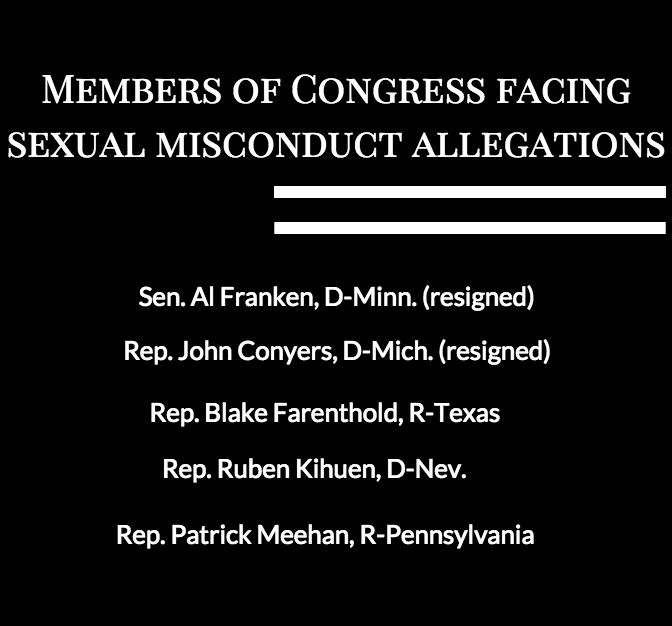
Policy experts like Jocelyn Frye, a senior fellow at the Center for American Progress and former member of the Obama administration, said that while messages and symbols highlighting this issue are important, lawmakers and employers need to follow through with reform that will benefit everyday workers, not just film stars and white-collar employees.
“We have to understand that this is not just a problem facing famous people. That’s the risk,” Frye said. “You have a bunch of actresses and political folks and media figures who by definition are able to tell their stories in a very public way … but they’re only a piece of the puzzle.”
Women of color face harassment and assault at higher rates than white women, but white women have largely dominated the #MeToo conversation. With high-profile cases like those of movie mogul Harvey Weinstein and Dr. Larry Nassar, who was convicted of sexually abusing scores of young female gymnasts, largely brought forward by white women, the emphasis was removed off of the systemic power imbalances that #MeToo movement founder Tarana Burke said are especially acute for women of color, who often don’t have the wealth or social capital to push back like other women with more means.
A symbolic moment like members of Congress wearing black is powerful, Noor Mir, a board member of Washington, D.C. activist group Collective Action for Safe Spaces, said, but it is crucial to include all women.
We have to really think about who occupies seats at the table, and when we’re talking about women are we really talking about all women?
Noor Mir“We have to really think about who occupies seats at the table, and when we’re talking about women are we really talking about all women?” Mir said.“We still have a long way to go, I think, in equalizing the narrative.”
Organizations like Hollaback! and Collective Action for Safe Spaces lobbied, often at the local level, to get governments to act. Mir praised a bill introduced by Brianne Nadeau, a D.C. council member, last year that is designed to educate city employees about how to identify and address street harassment and would follow New York City by becoming the second city to collect data on harassment’s many forms.
“If this legislation goes forward, we could really become national leaders in this,” Mir said.
She and May said increased criminalization is not the answer to street harassment.
“There is still this ever-present myth of it being mostly brown, mostly black and Latino men who are doing all this harassment, and that the victim is this sort of innocent white woman,” May said. “What we want to make sure that we’re not replicating those stereotypes, and we’re not entrenching those stereotypes into laws.”
On the federal level, Frye said, lawmakers should increase funding to not only combat sexual abuse, but to collect better data nationally. Equal Employment Opportunity Commission reports indicate that more research is needed to understand how it affects women from all walks of life, she said, and Congress could also expand the budget for support services for victims of sexual harassment.
Last month, Sens. Lindsey Graham, R-S.C. and Kirsten Gillibrand, D-N.Y, introduced a bill to put a stop to forced-arbitration clauses in employment contracts, making it illegal for employers to require employees to sign an agreement forfeiting their rights to take a harassment case to court.
But Mir cautioned that there is not one simple fix to the widespread sexual harassment problem. “When it comes it down to really grappling with this culture that allows for patriarchy to flourish, allows for people to think they own a woman’s body and are able to do whatever they want to it, that’s something that’s much deeper that no text or lawmaker or policy can necessarily fix in a day.”

